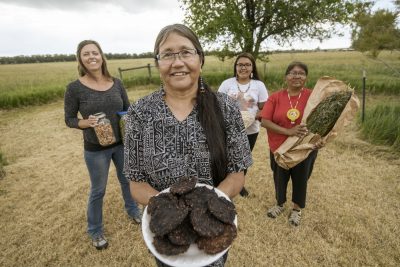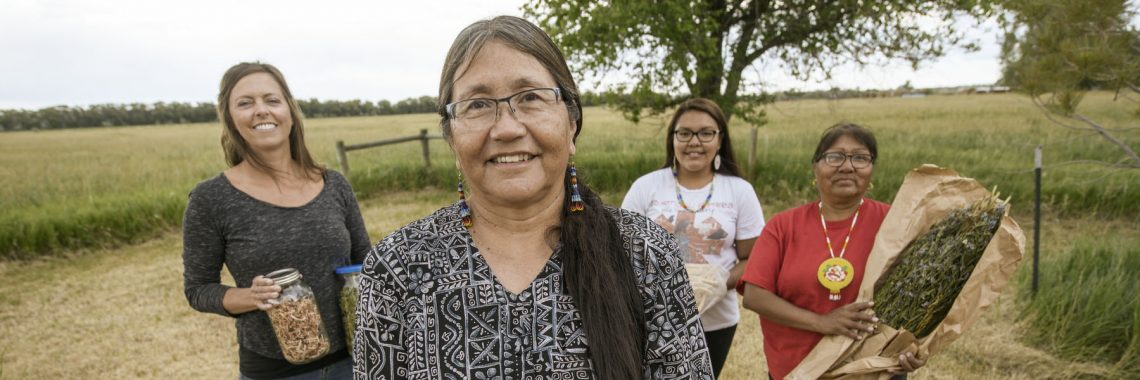
Members of the Restoring Shoshone Ancestral Food Gathering (RSAFG) group on the Wind River Indian Reservation are reclaiming knowledge about the use of Shoshone foods and preserving traditional methods of gathering and preparing those foods.
Traditional recipes, stories and other food knowledge have been shared among community members and non-native partners. The group gathers each month to collect, process and preserve foods such as yampah root and fireweed.
The efforts also rekindled childhood memories of food preparation.
“Back in the early days, we lived on all the wild game big and small. I remember watching my ‘gah goo’ (grandma) cooking the food for her large family,” said Vernetta Pantzetanga, an RSAFG advisory member who helped with collecting, processing and preparing traditional Shoshone foods. “Whether it was game meat or berries, it was the healthy way. Now as I look back, I find myself trying to prepare good, healthy food for my family just like my gah goo.”
RSAFG efforts were supported in 2018 by a National Institutes for Health grant through the University of Wyoming to study the effects of Shoshone ancestral foods on health, identity, culture and well-being.
The grant assisted community efforts to identify traditional Shoshone foods and how they were used, gathering and processing the foods, and preparing recipes for participants.
“The beautiful thing about community-based participatory research is that all is guided by the group,” said Jill Keith, an assistant professor in the Department of Family and Consumer Sciences who has worked with the Shoshone members since they began their efforts four years ago. “The RSAFG group knew what they wanted for their own community about the foods, where the foods are and how to process them.”
Some of that knowledge was known and some wasn’t – for example, how to correctly dig up a biscuitroot, clean and dry it, pound it into flour and then make into biscuits.
“We did all those steps together as a group,” Keith said, whose research emphasis includes factors that influence human eating behaviors (including sensory characteristics of food), the impact of changing diet behaviors on health outcomes, addressing health and education disparities and culturally relevant educational strategies.
Developing a photo and recipe book documenting the group’s efforts and creating a traditional foods database are key parts of the project. Recipes include teas made from wild berries and fir needles, biscuits made from root plant flour, and soups made with wild game such as buffalo, deer and elk.
The NIH grant is through the IDeA Networks for Biomedical Research Excellence through UW. The three-month health study began in January with participants receiving Shoshone foods each week for four weeks, keeping food diaries and attending an in-person data event each month.
The data collection included a survey, biometrics (blood pressure, height, weight and waist circumference), and blood draws (glucose, cholesterol, triglycerides) through Wyoming Health Fairs.
COVID-19 stopped such measurements in March, said Keith. Community members self-reported their physical measurements.
The findings will help determine if consuming traditional Shoshone foods made an impact on health. Study results are currently being analyzed.
The RSAFG group worked with the Eastern Shoshone Business Council and UW General Counsel to develop a data use and sharing agreement. All reports or presentations about study results must be approved by the RSAFG advisory group and the Rocky Mountain Tribal Institutional Review Board before sharing.
The photo-recipe book and traditional foods database are important for sharing the work of the group with the community, said Keith. Photographs document group members gathering and processing the foods.
The traditional foods database will be added to the group’s website upon project completion and identify the various plants and when to collect them, house what the plants are used for and offer traditional recipes. The database is intended for community members to reclaim traditional knowledge, and the RSAFG advisory group will guide the process of sharing the database.
The spiritual and cultural components also mean food is much more than something consumed, said Keith. Survey questions asked participants how the traditional diet affected their overall feeling of cultural connectedness and wellness.
An RSAFG elder provided cultural training to plant gatherers early on in the project to make sure plants were gathered respectfully.
“I would not want to speak to the cultural value of the food because I don’t have an indigenous lens,” said Keith. “But I’ve gathered and processed and preserved foods alongside community members, and it’s more than just collecting and eating food. It’s really connected. That aspect of it being very spiritual is very, very important.”
Commodity foods provided to reservations across the U.S. are a Westernized style of eating, said Keith.
They contain high amounts of refined carbohydrates and higher amounts of fatty meats and increased dairy and salt. Traditional diets were healthier and included physical activity as part of gathering and preparing, she said.
Caroline Mill’s mother gathered bitterroot when Caroline was young.
“It was a chore to help put food on the family table,” said Mills, an RSAFG advisory member who helped with collecting, processing and preparing traditional Shoshone foods.
“Eighty years later, I enjoy gathering healthy food for my family’s table,” she said. “This is food that is not available in the local grocery stores. And all the various berries provide antioxidants.”
Health is a huge issue and, because of colonization and changes to the food supply, health disparities are awful between white communities and Native American communities, said Keith.
“Reclaiming those foods is a really important part of that.”





